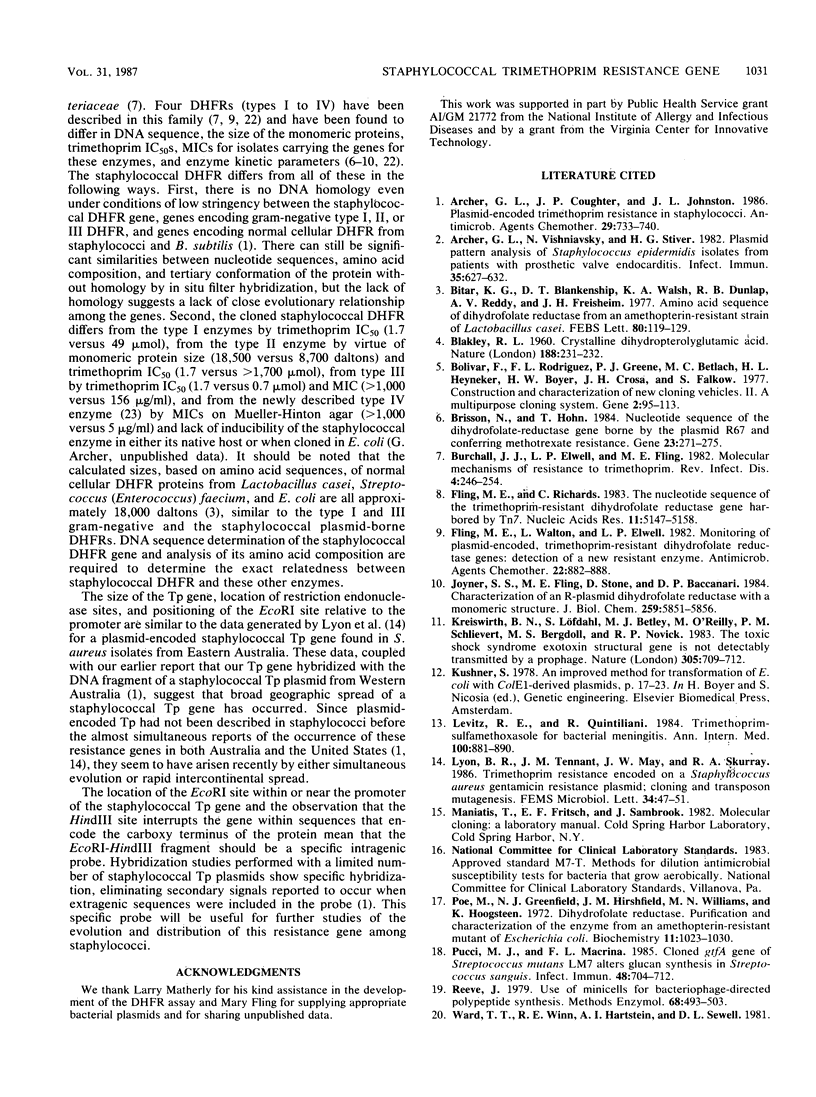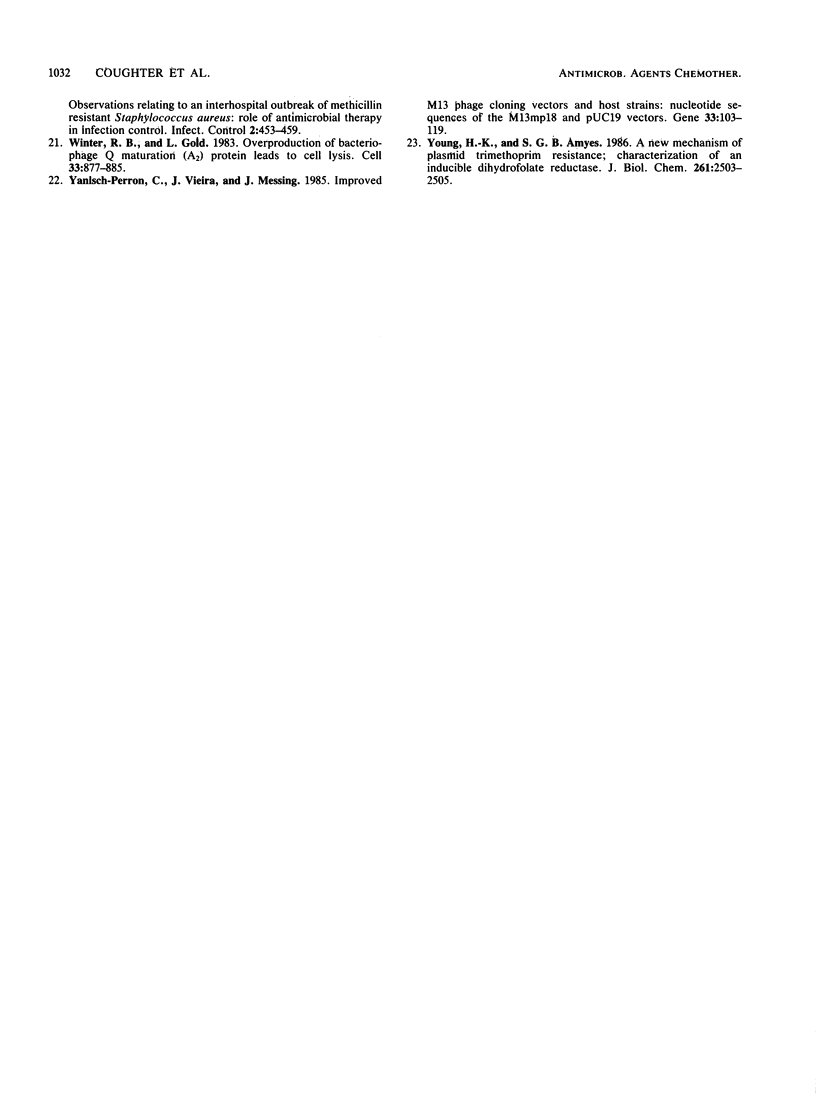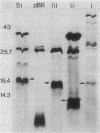Abstract
Resistance to trimethoprim (Tp) is mediated by a plasmid-encoded gene in staphylococci. The gene is responsible for high-level resistance (MIC, greater than 1,000 micrograms/ml) in both its native host and when cloned on high-copy-number vectors in Escherichia coli. Analysis of subclones of the staphylococcal Tp gene on E. coli expression vectors and estimation of the size of full and truncated proteins produced in E. coli minicells generated an approximate size limit of 505 base pairs for the gene and 18,500 daltons for the gene product. Crude extracts of E. coli containing the cloned gene had dihydrofolate reductase (DHFR) specific activity that was more than 100 times greater than that of control cells and more than 1,000 times more resistant to trimethoprim inhibition. The amount of trimethoprim required for a 50% reduction in the specific activity of staphylococcal DHFR differed from those of cells containing DHFR types I, II, or III, enzymes mediating Tp in members of the family Enterobacteriaceae. In addition, the size of the monomeric staphylococcal DHFR protein was larger than that of any of the gram-negative DHFRs both compared with published sequence data and as observed by direct comparison on polyacrylamide gels. Finally, there was no homology between a DNA fragment containing the cloned staphylococcal gene and DNA encoding any of the gram-negative DHFRs. Thus, the staphylococcal Tp gene codes for a single protein with DHFR activity that appears to be unrelated to DHFR genes that mediate Tp in members of the Enterobacteriaceae.
Full text
PDF





Images in this article
Selected References
These references are in PubMed. This may not be the complete list of references from this article.
- Archer G. L., Coughter J. P., Johnston J. L. Plasmid-encoded trimethoprim resistance in staphylococci. Antimicrob Agents Chemother. 1986 May;29(5):733–740. doi: 10.1128/aac.29.5.733. [DOI] [PMC free article] [PubMed] [Google Scholar]
- Archer G. L., Vishniavsky N., Stiver H. G. Plasmid pattern analysis of Staphylococcal epidermidis isolates from patients with prosthetic valve endocarditis. Infect Immun. 1982 Feb;35(2):627–632. doi: 10.1128/iai.35.2.627-632.1982. [DOI] [PMC free article] [PubMed] [Google Scholar]
- Bitar K. G., Blankenship D. T., Walsh K. A., Dunlap R. B., Reddy A. V., Freisheim J. H. Amino acid sequence of dihydrofolate reductase from an amethopterin-resistant strain of Lactobacillus casei. FEBS Lett. 1977 Aug 1;80(1):119–122. doi: 10.1016/0014-5793(77)80420-1. [DOI] [PubMed] [Google Scholar]
- Bolivar F., Rodriguez R. L., Greene P. J., Betlach M. C., Heyneker H. L., Boyer H. W., Crosa J. H., Falkow S. Construction and characterization of new cloning vehicles. II. A multipurpose cloning system. Gene. 1977;2(2):95–113. [PubMed] [Google Scholar]
- Brisson N., Hohn T. Nucleotide sequence of the dihydrofolate-reductase gene borne by the plasmid R67 and conferring methotrexate resistance. Gene. 1984 May;28(2):271–274. doi: 10.1016/0378-1119(84)90266-x. [DOI] [PubMed] [Google Scholar]
- Burchall J. J., Elwell L. P., Fling M. E. Molecular mechanisms of resistance to trimethoprim. Rev Infect Dis. 1982 Mar-Apr;4(2):246–254. doi: 10.1093/clinids/4.2.246. [DOI] [PubMed] [Google Scholar]
- Fling M. E., Richards C. The nucleotide sequence of the trimethoprim-resistant dihydrofolate reductase gene harbored by Tn7. Nucleic Acids Res. 1983 Aug 11;11(15):5147–5158. doi: 10.1093/nar/11.15.5147. [DOI] [PMC free article] [PubMed] [Google Scholar]
- Fling M. E., Walton L., Elwell L. P. Monitoring of plasmid-encoded, trimethoprim-resistant dihydrofolate reductase genes: detection of a new resistant enzyme. Antimicrob Agents Chemother. 1982 Nov;22(5):882–888. doi: 10.1128/aac.22.5.882. [DOI] [PMC free article] [PubMed] [Google Scholar]
- Joyner S. S., Fling M. E., Stone D., Baccanari D. P. Characterization of an R-plasmid dihydrofolate reductase with a monomeric structure. J Biol Chem. 1984 May 10;259(9):5851–5856. [PubMed] [Google Scholar]
- Kreiswirth B. N., Löfdahl S., Betley M. J., O'Reilly M., Schlievert P. M., Bergdoll M. S., Novick R. P. The toxic shock syndrome exotoxin structural gene is not detectably transmitted by a prophage. Nature. 1983 Oct 20;305(5936):709–712. doi: 10.1038/305709a0. [DOI] [PubMed] [Google Scholar]
- Levitz R. E., Quintiliani R. Trimethoprim-sulfamethoxazole for bacterial meningitis. Ann Intern Med. 1984 Jun;100(6):881–890. doi: 10.7326/0003-4819-100-6-881. [DOI] [PubMed] [Google Scholar]
- Poe M., Greenfield N. J., Hirshfield J. M., Williams M. N., Hoogsteen K. Dihydrofolate reductase. Purification and characterization of the enzyme from an amethopterin-resistant mutant of Escherichia coli. Biochemistry. 1972 Mar 14;11(6):1023–1030. doi: 10.1021/bi00756a012. [DOI] [PubMed] [Google Scholar]
- Pucci M. J., Macrina F. L. Cloned gtfA gene of Streptococcus mutans LM7 alters glucan synthesis in Streptococcus sanguis. Infect Immun. 1985 Jun;48(3):704–712. doi: 10.1128/iai.48.3.704-712.1985. [DOI] [PMC free article] [PubMed] [Google Scholar]
- Reeve J. Use of minicells for bacteriophage-directed polypeptide synthesis. Methods Enzymol. 1979;68:493–503. doi: 10.1016/0076-6879(79)68038-2. [DOI] [PubMed] [Google Scholar]
- Winter R. B., Gold L. Overproduction of bacteriophage Q beta maturation (A2) protein leads to cell lysis. Cell. 1983 Jul;33(3):877–885. doi: 10.1016/0092-8674(83)90030-2. [DOI] [PubMed] [Google Scholar]
- Yanisch-Perron C., Vieira J., Messing J. Improved M13 phage cloning vectors and host strains: nucleotide sequences of the M13mp18 and pUC19 vectors. Gene. 1985;33(1):103–119. doi: 10.1016/0378-1119(85)90120-9. [DOI] [PubMed] [Google Scholar]
- Young H. K., Amyes S. G. A new mechanism of plasmid trimethoprim resistance. Characterization of an inducible dihydrofolate reductase. J Biol Chem. 1986 Feb 25;261(6):2503–2505. [PubMed] [Google Scholar]




